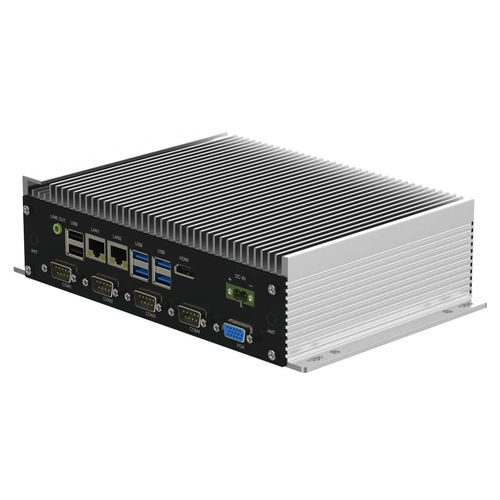
#Product Trends
TAICENN's newest 8th gen. Intel Core industrial Box computer for wind power application
At present, for low-carbon, environmentally-friendly and sustainable development, countries around the world have successively listed the development of renewable energy as an important goal.
Background:
With the improvement of human living standards, the demand for energy is also increasing. After hundreds of years of consumption of oil, natural gas, coal and other resources, they have already moved towards an irreversible exhaustion trend, which has also worsened the deterioration of the global environment. Wind Farm, abbreviated as wind power plant, is a power plant that uses wind to generate electricity and is a type of renewable energy power plant. At present, for low-carbon, environmentally-friendly and sustainable development, countries around the world have successively listed the development of renewable energy as an important goal. Under this circumstance, wind power plants have become their preferred energy development focus.
As a kind of clean renewable energy, wind energy has attracted more and more attention from the world. Its reserves are too huge and the global wind energy is about 2.74×109MW, of which the available wind energy is 2×107MW, which is 10 times larger than the total amount of hydropower that can be developed and utilized on the earth. Chinese wind energy reserves are large and widely distributed, its wind energy reserves on land alone are about 253 million kilowatts.
For example, GE provided Huaneng Group's Dali Longquan Wind Power Project with 55 sets of smart wind turbines with a total installed capacity of 151MW. The installed capacity of Tianfengshan Longquan Wind Farm is expected to generate 525.077 million kWh of electricity annually, which can save about 173,300 tons of standard coal each year. Correspondingly, it can reduce waste gas emissions caused by coal burning each year, including 363,800 tons of carbon dioxide and 1.5542 million tons of sulfur dioxide. There are 1.5542 million tons of nitrogen oxides and 46.63 tons of soot. In addition, it can save 1.3254 million cubic meters of fresh water every year, and reduce the corresponding waste water discharge and warm water discharge.
Application Requirements:
Wind power generation facilities are generally installed in the outdoors, with harsh environments with dust and wind, and even marine environments. This project is an offshore wind power plant, a new type of environmentally friendly power plant that uses offshore wind resources to generate electricity. The project has very high requirements on the performance and stability of the industrial computer. This is not only because of the actual efficiency of the equipment, but also the ocean environment is very difficult and inconvenient for daily maintenance. Therefore, the wind power plant need reliable and professional industrial computer solutions.
In offshore wind power generation applications, industrial computers are generally used for monitoring and control of wind tower cranes. It can monitor, control, and exchange information on field equipment to achieve data collection, equipment control, measurement, parameter correction, and various information early warning functions.
TAICENN’s solutions and products:
As a solution provider & manufacturer of Industrial computers, Industrial Panel PC and monitor products, TAICENN has confirmed the actual application environment and hardware requirements after several discussions with wind power project customers. The customer application is an offshore wind power plant project, and the application environment is a complicated ocean environment.
We finally confirmed to offer with a ruggedized fanless industrial computer, TAICENN TBOX-2830 industrial box computer, which TAICENN’s modular concept design and manufacturing, adapt Intel latest 8th gen. Whiskey Lake platform quad-core and eight-thread i7-8565U processor solution, Industrial grade 8GB memory and 256GB SSD storage, rich IO interfaces include: 2 network ports, 8 USB, 8 serial ports (2 isolated RS485 and 2 isolated RS422 serial ports), 1 HDMI and 1 VGA interface. The whole system can meet the industrial -20 ~ +70C temperature range. For this project on the ocean, the whole machine is specially treated with three-proof coating to provide high stability and reliability for wind power generation applications.
TBOX-2830 Specifications:
● High-strength, compact, sheet metal structure, large-area finned heat-sink, fanless design;
● Intel 8th-gen. Whiskey lake-U platform, Core i7-8565U 1.8Ghz, burst to 4.6Ghz;
● DDR4, max. up to 16GB memory, 2.5 SATA and mSATA storage;
● Wide voltage DC 9 ~ 24v input, with over-current and over-voltage protection functions;
● Industrial operating temperature range of -20 ~ + 70C;
● Robust and compact design with dimensions 236.5 x 150 x 60 (mm)
● Optional with 3G / 4G / LTE, Wi-Fi / Bluetooth and other industrial modules;
● Rich IO design: 2* GLAN, 8* COM (4* RS485/RS422), 4* USB3.0, 4* USB2.0, 1* HDMI, 1* VGA, Line-out, 1* GPIO + 1* CAN (optional)





